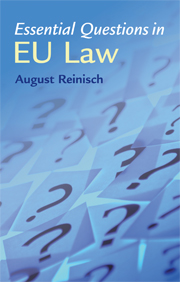Book contents
- Frontmatter
- Contents
- List of abbreviations
- Preface
- 1 History of European integration
- 2 The institutional framework
- 3 The making of Community law
- 4 The effect of Community law
- 5 Judicial control within the Community
- 6 Protecting fundamental rights within the Community
- 7 The free movement of goods
- 8 The free movement of persons
- 9 EC competition law
- 10 Selected Community policies
- 11 The EC and the EU as international actors
- Index
3 - The making of Community law
Published online by Cambridge University Press: 05 June 2012
- Frontmatter
- Contents
- List of abbreviations
- Preface
- 1 History of European integration
- 2 The institutional framework
- 3 The making of Community law
- 4 The effect of Community law
- 5 Judicial control within the Community
- 6 Protecting fundamental rights within the Community
- 7 The free movement of goods
- 8 The free movement of persons
- 9 EC competition law
- 10 Selected Community policies
- 11 The EC and the EU as international actors
- Index
Summary
Community law, that is, the law of the supranational organisation European Community, consists of so-called primary and secondary law. The concept of primary law relates to law made by the Member States via their international law treatymaking powers. Therefore, it comprises the initial 1957 Treaty of Rome plus various treaty amendments, such as the SEA, the Maastricht, Amsterdam and Nice Treaties, as well as the accession treaties. Secondary law, on the other hand, refers to law made by the Community's institutions based on the authorisation contained in the Treaties (the primary law), such as regulations, directives and decisions, as well as soft-law instruments such as recommendations and opinions.
Article 249 TEC briefly characterises the legal quality of these legislative instruments:
In order to carry out their task and in accordance with the provisions of this Treaty, the European Parliament acting jointly with the Council, the Council and the Commission shall make regulations and issue directives, take decisions, make recommendations or deliver opinions.
A regulation shall have general application. It shall be binding in its entirety and directly applicable in all Member States.
A directive shall be binding, as to the result to be achieved, upon each Member State to which it is addressed, but shall leave to the national authorities the choice of form and methods. […]
- Type
- Chapter
- Information
- Essential Questions in EU Law , pp. 35 - 49Publisher: Cambridge University PressPrint publication year: 2009



